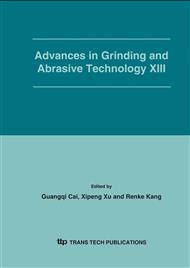p.146
p.151
p.156
p.161
p.166
p.171
p.176
p.181
p.186
Experimental Study on Creep Feed Deep Grinding Titanium Alloy with Slotted CBN Grinding Wheel
Abstract:
In order to improve the grindability of titanium alloys, the inhibition of chemical affinity between abrasives and titanium alloys and cooling enhancement in grinding zone are carried out in this paper. Slotted electroplated CBN grinding wheels with optimum topography are used, and different grinding fluid supply systems such as conventional tangential spraying coolant supply, inner chamber coolant jet impingement, radial high-pressure coolant jet impingment are employed in creep feed deep grinding experiments on titanium alloy (TC4). The experimental results show that high-pressure jet impingement has remarkable cooling effect. The temperature of the workpiece surface can be steadily kept below the critical film boiling temperature 120~130°C, while the workpiece surfaces is badly burnt with conventional coolant supply. The study will exploit an important research orientation that has great potential in high efficiency grinding. Further perfection of this study will not only enable us to increase the available material removal rate to a new level but also solve the workpiece burn problem of the difficult-to-machining materials in high efficiency grinding.In order to improve the grindability of titanium alloys, the inhibition of chemical affinity between abrasives and titanium alloys and cooling enhancement in grinding zone are carried out in this paper. Slotted electroplated CBN grinding wheels with optimum topography are used, and different grinding fluid supply systems such as conventional tangential spraying coolant supply, inner chamber coolant jet impingement, radial high-pressure coolant jet impingment are employed in creep feed deep grinding experiments on titanium alloy (TC4). The experimental results show that high-pressure jet impingement has remarkable cooling effect. The temperature of the workpiece surface can be steadily kept below the critical film boiling temperature 120~130°C, while the workpiece surfaces is badly burnt with conventional coolant supply. The study will exploit an important research orientation that has great potential in high efficiency grinding. Further perfection of this study will not only enable us to increase the available material removal rate to a new level but also solve the workpiece burn problem of the difficult-to-machining materials in high efficiency grinding.
Info:
Periodical:
Pages:
166-170
Citation:
Online since:
February 2006
Authors:
Price:
Сopyright:
© 2006 Trans Tech Publications Ltd. All Rights Reserved
Share:
Citation:


